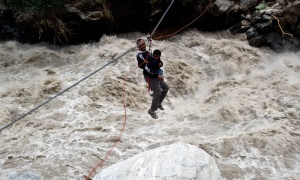It was the best of times, it was the worst of times…
Best
Taken at face value, this is just a really ballsy, really beautiful shot of somebody walking a tightrope/slackline over Yosemite Falls. Completely ignoring the fact that I generally have the balance of a member of Delta House (Animal House) on a Friday night, I wouldn’t do that on my most fearless day even if I could walk a razor straight line.
The rigging, however, is what I was most focused on. The line that the guy is walking on is anchored on terra firma on one side and is anchored off to another highline on the other side!!!
The deflection in the anchor highline looks to be practically nil. The forces of a highline pulling on a highline, especially one with very little deflection, are likely to be pretty darn high. I guess that it worked, so I shouldn’t take too much issue with it. But there are several things that I saw that gave me a bit of pause. Aside from the fact that it’s a highline attached to a highline, the floating anchor side is attached with either multiple slings or a doubled up sling. Regardless, it is presenting a hell of a tri load on the single carabiner used for the attachment.
Secondly, it doesn’t seem like the smartest idea to me to be cutting the trackline with a knife; especially with one so small, doesn’t lock, and isn’t tethered off. The release of tension on the anchor highline causes the predictable, violent release. The chances for that blade to cut something you’re hanging on is just too much risk for me… but nothing bad happened here, so maybe I’m just more risk averse. Maybe a happy compromise would have been cutting the line with some scissors or trauma shears. I’m curious why they had to cut the line at all, though. It had to get out to that point somehow prior to it being tensioned.
Regardless, it looked like a great time to be communing with nature while on rope.
Worst
A not so great communing with nature while on rope is summed up in this picture from India.
Torrential rains in India this week caused some massive flooding and landslides that have left over 1000 people dead. HERE is the story.
Nice use of two tracklines in order to keep the sag to a minimum and people out of the water. The slack control lines can be forgiven because, according to the article, these type of highlines were being used to transport multiple people to safety in a short amount of time. A good trade off/ system analysis/ threat assessment in my opinion.


